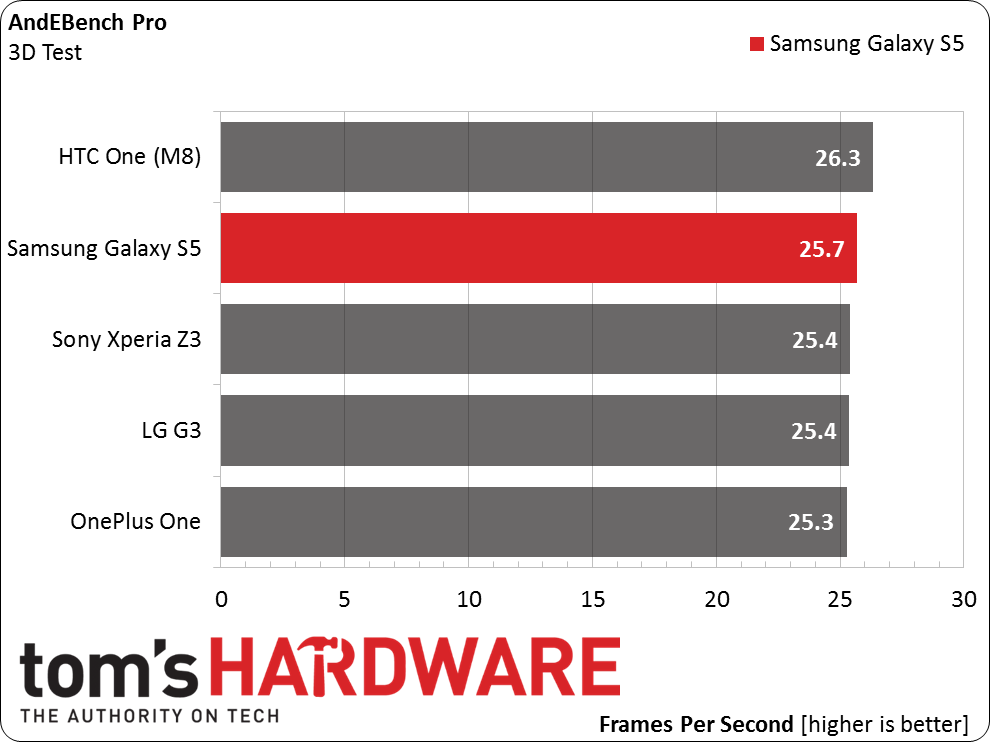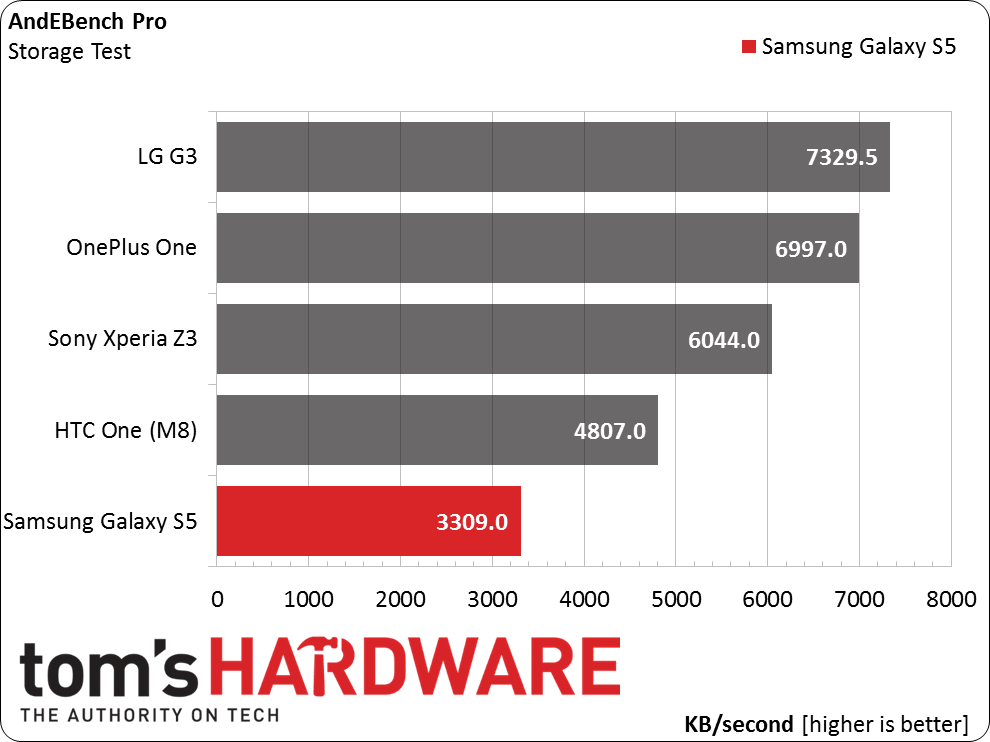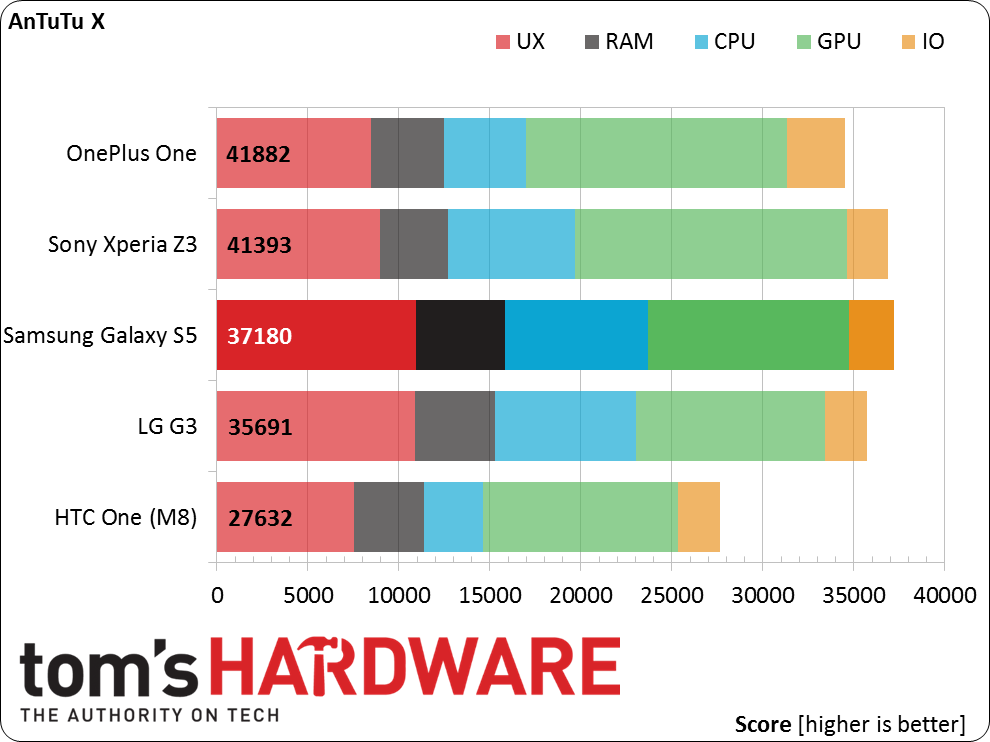Samsung Galaxy S5 Smartphone Review
Will the gravity well from Galaxy S5 capture your interest, or will you streak past with escape velocity?
Why you can trust Tom's Hardware
Results: CPU Core Benchmarks
AnTuTu X
AnTuTu is an Android system benchmark designed to test the performance capabilities of four major aspects of mobile devices: Graphics (encompassing 2D, UI and basic 3D), CPU (fixed, floating-point and threading), RAM (read and write) and I/O (read and write).
The results for AnTuTu X are sorted based on the overall scores, which are the values shown within the left end of each bar. The overall score is not simply a cumulative value based on the individual test scores. Instead, it’s a separate calculation with its own distinct value. This is why the length of the bars don’t correlate with the overall score.
The total spread between the LG G3 and the OnePlus One is 17%. Both the S5 and G3 do well in the UX, RAM and CPU tests, all of which stress threaded CPU performance to some degree, but fall short when testing the GPU. The opposite is true for the OnePlus One and Sony Z3; they both score higher in the GPU test than the other three. The One and Z3 are both newer phones running Android 4.4.4 (versus 4.4.2 for the others), so it's possible they have newer GPU drivers as well.
As expected, the HTC One (M8) posts the lowest scores in the CPU-centric tests due to its lower CPU clock frequency.
AndEBench Pro
AndEBench Pro is produced by The Embedded Microprocessor Benchmark Consortium (EEMBC) and uses carefully designed, low-level algorithms for testing CPU, GPU, memory and storage subsystem performance. The benchmark workload includes XML parsing, data compression, GUI rendering, photo manipulation and cryptography tasks.





We don't see any surprises in CPU or GPU performance: all of the devices demonstrate similar performance except the HTC One's lower score in the CPU-centric CoreMark-HPC test. There's some variation in memory performance where the OnePlus One shows about a 8% and 9% advantage in memory bandwidth and memory latency, respectively.
The S5 does poorly in the Storage test, achieving less than half the throughput as the OnePlus One and G3. Looking more closely at the Storage sub-tests in the table below, the G3 performs 2x-3x better in each test. The 256K sequential and random read tests show the G3 with a 3x advantage over the S5.
Get Tom's Hardware's best news and in-depth reviews, straight to your inbox.
| Header Cell - Column 0 | AndEBench Pro Storage Test (Values in KB/s - Higher is better) | |||||||
|---|---|---|---|---|---|---|---|---|
| Row 0 - Cell 0 | 512B SW | 512B RW | 4K SR | 4K SW | 4K RR | 4K RW | 256K SR | 256K RR |
| Galaxy S5 | 149 | 287 | 8568 | 922 | 9581 | 2413 | 40183 | 40081 |
| LG G3 | 454 | 516 | 20328 | 1976 | 22539 | 3930 | 125718 | 121397 |
First letter: S=sequential, R=random
Second letter: R=read, W=write
Basemark OS II Full (Anti-Detection)
Basemark OS II is an all-in-one tool designed for measuring overall performance of mobile devices. It scores each device in four main categories: System, Memory, Graphics and Web. The System score reflects CPU and memory performance, specifically testing integer and floating-point math, along with single- and multi-core CPU image processing using a 2048x2048, 32-bit image. Measuring the transfer rate of the internal NAND storage (Memory) is done by reading and writing files with a fixed size, files varying from 65KB to 16MB, and files in a fragmented memory scenario. Calculating the Graphics score involves mixing 2D/3D graphics inside the same scene, applying several pixel shader effects and displaying 100 particles with a single draw call to test GPU vertex operations. The benchmark is rendered at 1920x1080 off-screen 100 times before being displayed on-screen. Finally, the Web score stresses the CPU by performing 3D transformations and object resizing with CSS, and also includes an HTML5 Canvas particle physics test.
There are no real surprises in Basemark OS II. The overall scores for the 8974AC Snapdragon 801-based devices fall within a 9% range. The score for the lower-clocked 8974AB SoC in the HTC One (M8) is 13% lower than the quickest 801, the Sony Z3.
Geekbench 3 Pro (Anti-Detection)
Primate Labs' Geekbench offers a wide selection of cross-platform compatibility, with apps available for Windows, OS X, Linux, iOS and Android. This simple system benchmark produces two sets of scores: single- and multi-threaded. For each, it runs a series of tests in three categories: Integer, Floating Point and Memory. The individual results are used to calculate category scores, which, in turn, generate overall Geekbench scores.
Both the OnePlus One and HTC One (M8) pull ahead of the S5 in the Memory test, just as they did in AndEBench Pro. The Snapdragon 801 devices all perform the same in the single-threaded CPU tests, with the HTC One (M8) falling behind by 16%
The multi-threaded tests yield more variation. The S5 scores 13% better in both the Integer and Floating Point Multi-Core tests.
The reason we see more variation in the Multi-Core benchmark is because each OEM configures their CPU governors differently. Some optimize for performance, while others optimize for power consumption, placing additional constraints on CPU clock frequency or on how many cores can be active in a given time slice. This behavior is readily apparent when monitoring the real-time CPU usage while running the benchmark. The S5 keeps all four cores running at ~2.5GHz for the majority of the benchmark run. The G3, however, never seems to run all four cores at peak frequency, electing to either run all four cores at reduced frequency or letting two cores go idle while the other two run at max speed. Most of the time this isn't an issue, since apps are generally single-threaded and background tasks are usually short duration. Where this effect will be noticeable is when playing games, which are multi-threaded, and loading apps.
MobileXPRT 2013
Principled Technologies' MobileXPRT 2013 is a modern SoC benchmark for Android. It consists of 10 real-world test scenarios split into two categories of testing: Performance and User Experience. The Performance suite contains five tests: Apply Photo Effects, Create Photo Collages, Create Slideshow, Encrypt Personal Content, and Detect Faces to Organize Photos. Performance results are measured in seconds. The User Experience suite also has five tests: List Scroll, Grid Scroll, Gallery Scroll, Browser Scroll, and Zoom and Pinch. These results are measured in frames per second. The category scores are generated by taking a geometric mean of the ratio between a calibrated machine (Motorola's Droid Razr M) and the test device for each subtest.
The Galaxy S5 performs on par with the Sony Z3, as expected. The HTC One (M8) is 8% slower than the S5, which equals their difference in CPU clock frequency.
The S5 does well in every test except Gallery Scroll. As expected, there isn't much variation in this test, with an overall performance spread of 9%.
In terms of CPU and memory performance, the Galaxy S5 does as well or a little better than its Snapdragon 801 peers, particularly in multi-threaded scenarios. It's unfortunate then that it performs so poorly in the storage test.
Current page: Results: CPU Core Benchmarks
Prev Page How We Tested Next Page Results: HTML5 And JavaScript Benchmarks-
grumpigeek My Galaxy S5 in in an Urban Armor Gear case that looks great and protects the phone, so I don't really care what it looks like.Reply
The device is 100% reliable and I have found the battery life to be excellent - way better than any smartphone I have had previously.
-
implantedcaries Guys you are reviewing a mobile which was released a year and then calling it average compared to competitiReply -
firefoxx04 I have an s5. This review would have been welcomed a year ago.Reply
The phone is top notch. I've known this for a while. -
implantedcaries Guys you are reviewing a mobile which was released a year back and then calling it average compared to competition?? Seriously? Yes I agree S5 is not the most exciting prospect out there for new mobile buyers now, but it wasn't so in 2014 when it was actually launched. Also its one of the very few mobiles already receiving lollipop updates.. No mention of that.. Any hidden agenda against Samsung?Reply -
FritzEiv Folks, you're right. This review is quite late. We began testing the S5 a long time ago, but we've had a bit of a backlog of smartphones to review since Matt (our senior mobile editor) started on staff and we're just catching up. We aren't trying to pretend it's a new phone, thus we haven't put it up in our main feature carousel; but we did want to publish this and others just to have them for archival and future referral and comparison purposes. We are working on other smartphones that are little more current and then we hope to be "on time" as new ones arrive. Hence, for example, Matt's performance preview of Qualcomm's Snapdragon 810 earlier this week. We've been a bit more timely on devices like the OnePlus and the iPhone reviews as well. But hey, continue your sarcasm, because we probably deserve it. Just want you to know why we are doing this, that we're not trying to fool anyone, and that we'll be caught up in short order. Thanks for your patience.Reply
- Fritz (Editor-in-chief) -
Mac266 One thing in this review irritated me: the whole "it's ugly" thing. It might not suit you, but lots of people like the way it looks. Aesthetics are purely subjective, and should definitely not be judged a con on one mans opinion.Reply -
peterf28 Iam not buying a smartphone again where the chipset drivers are not open source. Like what samsung did with the S3, it is stuck on Android 4.3, and there is nothing you can do. All the custom roms are unstable crap because there are no up to date drivers For current kernels. It is like buying a PC without the possibility to update the OS . Would you buy that ?Reply -
jdrch FYI phone speakers are placed on the back of phones to take advantage of acoustics when the phone is laying on a surface. The surface spreads and reflects the sounds back to the user much better than the speaker itself would. Try it yourself.Reply





